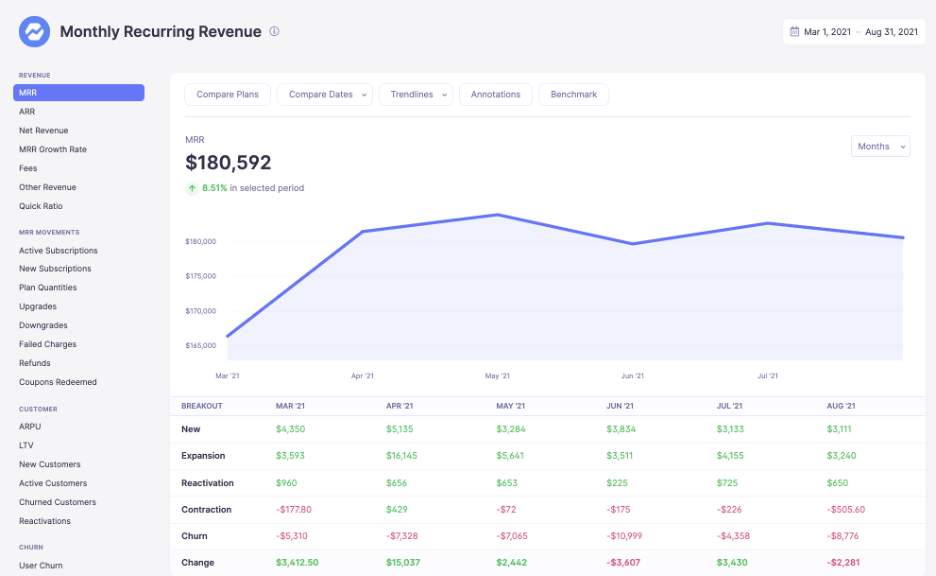Table of Contents

Working capital is the difference between a company’s current assets and its current liabilities. It is sometimes referred to as net working capital, and it is one of the measures of a company’s liquidity. You can find all the information you need to calculate working capital on the balance sheet.
In this article, we are going to explain current assets, current liabilities, and how to calculate working capital. We’ll look into why working capital is important, what liquidity means, and some related measures such as the quick ratio and the current ratio.
While the equations are all fairly simple, finding the data to calculate all of these metrics is not.
Baremetrics makes it easy to collect and visualize all of your sales data so that you always know how much cash you have on hand, which clients have paid, and who you still owe services to.
When you have many clients, some are subscribed on an annual basis while others are monthly, with multiple tiers and various add-ons. This makes it difficult to calculate your MRR, ARR, LTV, and so much more. Thankfully, there is Baremetrics to do all of this for you.
Check out what the MRR dashboard looks like right here:
Baremetrics can monitor your SaaS quick ratio. It can even help make sure you collect on delinquent accounts. Integrating this innovative tool can make financial analysis seamless for your SaaS company, and you can start a free trial today.
What are current assets?
Current assets include basically everything that is currently cash or will be turned into cash within a year.
Cash and Cash Equivalents: Cash can be anything from notes in your petty cash to the balance of your checking account. Cash equivalents are those items that can be turned into cash immediately, such as marketable securities (i.e., stocks and bonds).
Accounts Receivable: This particular journal is only used under the accrual accounting system and not the cash accounting system. Accounts receivable includes the revenue that your company has recognized but not yet collected. As you receive payments for the services you have already provided, this account will decrease while your cash account will increase.
Inventory: Inventory includes all supplies on hand to produce products for sale as well as the products ready to be sold. Many SaaS businesses have zero inventory.
What are current liabilities?
Current liabilities are the debts you owe that must be paid within the next year. For a SaaS business, the deferred revenue category is particularly important.
Accounts Payable: Along with accounts receivable, accounts payable are only used in the accrual accounting system. These are expenses that have been incurred but not yet paid for, such as the electricity bill sitting on your desk or invoiced services that you do not need to pay immediately.
Current Debt/Notes Payable: These are the debts you need to pay completely within a year.
Current Portion of Long-Term Debt: Some companies separate out the part of long-term debt that needs to be paid within the following year. For example, your mortgage might be 25 years long, but the current portion includes all the payments you’ll make over the next year.
Deferred Revenue: Counterintuitively, if you have collected money for services that have not yet been rendered, this is a liability because you owe the client for those services.
How do you calculate working capital?
The working capital formula is very simple:
Working Capital = Current Assets – Current Liabilities
You essentially tally up all of your current assets and then subtract all of your current liabilities.
Liquidity
Liquidity refers to the availability of cash or cash equivalents on hand for planned and sudden expenses. Generally, high liquidity is considered safer as you have the agility to dodge unforeseen expenses as well as to jump on surprise opportunities.
Indeed, there are two main indicators of whether a business will be able to survive: profitability and liquidity. As counterintuitive as it may be, a profitable company without sufficient liquidity is destined to fail, even though a not particularly profitable company with a strong positive liquidity can survive long enough to turn around its profitability. For more on this, take a look at our recent article on net cash flow.
What are some other liquidity measures?
There are several ways to calculate liquidity. The current ratio and the quick ratio are calculated with the same information as working capital, which is found on the balance sheet.
Current Ratio = Current Assets/Current Liabilities
Quick Ratio = (Cash + Cash Equivalents + Marketable Investments + Accounts Receivable)/Current Liabilities
While the current ratio uses all current assets and liabilities, the quick ratio removes inventory. This is because the assumption that inventory will be turned into cash within a year is based on the further assumption that the company will operate well and efficiently during that year. This could be a dangerous assumption, as markets change and inventory can then be stranded in warehouses until placed on deep discounts.
The net cash flow takes information from the statement of cash flow, which, in addition to the balance sheet discussed above, is one of the three main financial statements (with the income statement being the third).
Net Cash Flow = Total Cash Inflows – Total Cash Outflows
While the quick ratio, the current ratio, and working capital all measure the liquidity of a company at a point in time, the net cash flow shows how liquidity is changing over time.
be honest
What are the limitations of these measures in SaaS?
All of these measures have their limits. For example, having a high positive net cash flow might not always be a good thing. If that cash flow came from a massive new loan designed to keep the company afloat while patronage continues to decrease, then it is hardly a good thing.
Similarly, a large negative cash flow might originate from the purchase of new equipment that will improve productivity and decrease long-term costs.
SaaS companies that bring in revenue through a subscription model typically have high accounts receivable and/or deferred revenue. When this is the case, the current ratio, quick ratio, and working capital can all be skewed.
Involuntary churn could mean the accounts receivable account is higher than the actual collectible revenue, which would make these measures overly optimistic. For this issue, Baremetrics Recover can help! Up to 9% of MRR is lost to failed payments, and Baremetrics has the tool to minimize this.
Sign up for the Baremetrics free trial and stop losing revenue to failed payments now.
Conversely, a very high deferred revenue account might make these measures less impressive, even though an essentially interest-free loan from clients is generally a benefit to the company.
Another issue that is often overlooked when analysts rely too heavily on these measures is seasonality. For example, if you have a yearly campaign in December to push your monthly subscribers to buy annual subscriptions, then you’ll probably see a spike in your cash as well as deferred revenue during the first few months of the year.
Similarly, if you give your employees large bonuses in summer, then you’ll need more cash on hand in the summer months to account for that higher payroll. Knowing the seasonality of your business will help in the interpretation of these measures.
Finally, more is not always better in this case! If your working capital is consistently high, it might be an indication that you are not using your capital efficiently. It might be time to invest more in your future or to give more back to shareholders in the form of dividends.
Is there a better measure of liquidity for SaaS?
While not necessarily a better measure of liquidity, the SaaS quick ratio does provide unique, specific, and actionable information when analyzing the revenue data of your SaaS business. The information it provides is different from that of working capital, and it is worth the time to calculate the SaaS quick ratio for a better understanding of your company.
The SaaS quick ratio is based on the different types of MRR (monthly recurring revenue) and is calculated as follows:
SaaS Quick Ratio = (New MRR + Expansion MRR + Reactivation MRR)/(Contraction MRR + Churned MRR)
As a general rule of thumb, a SaaS quick ratio of <1 indicates a present danger for your company as you are churning clients more quickly than you are attracting new ones. While a SaaS quick ratio of 1–4 indicates growth, the pace might be too slow to guarantee the longevity of your business. Generally, a SaaS quick ratio of >4 is a safe and comfortable growth trajectory.
As easy as it is to calculate your SaaS quick ratio once you have the numbers, getting them is another question. Your SaaS company likely uses CRM and/or payment processing software, and the data required to compute all required MRR values can be all over the place. Integrating innovative software that can cull MRR values from CRM and payment processing systems is a valuable shortcut.
Baremetrics monitors your SaaS quick ratio, computing everything from your company’s MRR as shown by your membership or subscription payments/upgrades to your monthly churn rates. Integrating this innovative tool can make financial analysis seamless for your SaaS company, and you can start a free trial today.




